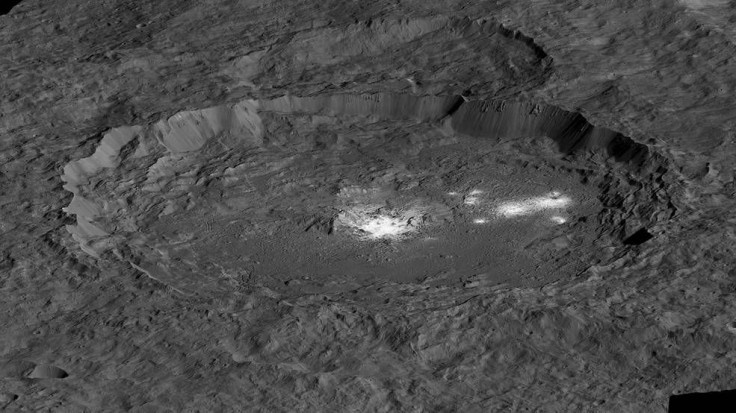NASA Video Explains Bright Spots On Ceres: Geological Processes Show Active Planet

NASA's Dawn spacecraft, orbiting dwarf planet Ceres, captured images of several bright spots on its surface. The satellite captured over 300 areas, which were brighter than the surroundings, spiking the curiosity of astro-nuts across the world. Now, scientists at NASA released a video explaining what these bright spots are and what they indicate.
Scientists have a better idea of how these reflective areas formed and changed over time from the many images and crucial data they obtained from Dawn, which has been orbiting Ceres since March 2015. They said it points to an active, evolving world.
"The mysterious bright spots on Ceres, which have captivated both the Dawn science team and the public, reveal evidence of Ceres' past subsurface ocean, and indicate that, far from being a dead world, Ceres is surprisingly active. Geological processes created these bright areas and may still be changing the face of Ceres today," said Carol Raymond, deputy principal investigator of the Dawn mission, based at NASA's Jet Propulsion Laboratory in Pasadena, California in a NASA press release.
The 300 bright areas on Ceres are classified into 3 groups.
The first group contains spots with the most reflective material on Ceres usually found on crater floors. The Occator Crater hosts two of the most prominent bright areas. Cerealia Facula, an area in the center of the crater, consists of bright material covering a 6-mile-wide pit, within which sits a small dome. All the bright material in Occator Crater is made of salt-rich material, which was once likely mixed in water, said the release.
The second group is the bright material found on the rims of craters, streaking down toward the floors. These indicate expulsion of the material due to some impact in the past.
Separately, in the third category, bright material can be found in the substance ejected when craters were formed. The mountain Ahuna Mons on the dwarf planet has its own unique material, which is unaffiliated with any impact crater. According to the video, this likely cryovolcano, a volcano formed by the gradual accumulation of thick, slowly flowing icy materials, has prominent bright streaks on its flanks.
"Previous research has shown that the bright material is made of salts, and we think subsurface fluid activity transported it to the surface to form some of the bright spots," Stein said.

The team said the bright areas of Occator seem so distinct from one another because there was a reservoir of salty water beneath the region. Scientists attributed this to fluid driven to the surface by a small amount of gas.
Various regions on Ceres formed bright spots through different geological processes. In some regions, vapor could have shot out due to pressure differences, carrying ice and salt with it, creating a bright spot. In other regions, ice may have seeped through crack forming ice domes like seen in the Cerealia bright spot.
Dawn scientists believe a large body slammed into Ceres, excavating the 57-mile-wide crater. The impact may have created fractures through which liquid emerged later.
As Dawn continues the final phase of its mission, in which it will descend to lower altitudes than ever before, scientists continue learning about the origins of the bright material on Ceres and what gave rise to the enigmatic features in Occator.
The Dawn mission is seen as one of our farthest explorer in space. The mission has led to several important findings for NASA and the world. It is currently the only spacecraft ever to orbit two destinations beyond Earth and the only to orbit an object in the main asteroid belt between Mars and Jupiter.
Dawn's exploration of protoplanet Vesta revealed to us that it was very similar to Earth than to typical asteroids. Ceres was the first dwarf planet discovered by Dawn and it was the first dwarf planet we documented.
The study was published in journal Icarus and was led by Nathan Stein, a doctoral researcher at Caltech in Pasadena, California.
© Copyright IBTimes 2024. All rights reserved.





















